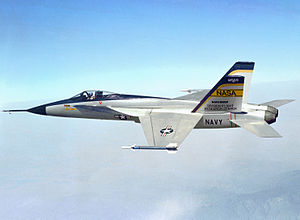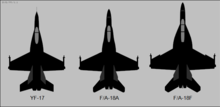Northrop YF-17
| Northrop YF-17 Cobra | |
|---|---|
 The 1st prototype of the YF-17 during tests at Dryden Flight Research Center , 1976 |
|
| Type: | light fighter aircraft |
| Design country: | |
| Manufacturer: | |
| First flight: |
June 9, 1974 |
| Commissioning: |
Flight tests ended in 1976 |
| Production time: |
Was never mass-produced |
| Number of pieces: |
2 |
The Northrop YF-17 Cobra was a prototype as part of the US Air Force's Lightweight Fighter Program ( LWF ) . This was initiated because it was believed that the F-15 Eagle was too expensive to be able to produce it in sufficient numbers. However, economic policy interests also played a role, particularly with regard to the export market. The YF-17, which is in the broadest sense a further development of the F-5 , was defeated by its competitor, the YF-16 , in the LWF program .
After the defeat in the LWF program, the YF-17 was further developed by McDonnell Douglas as part of the new Naval Fighter Attack Experimental Program ( VFAX ) to become the F / A-18 Hornet . The larger F-18 eventually went into service with the US Navy and the US Marine Corps , where it replaced the A-7 Corsair II and the F-4 Phantom II as a complement to the F-14 Tomcat .
history
development
The basic construction of the YF-17 was designed as part of the company's internal Northrop project N-300 as early as 1965. The N-300 is a derivative of the F-5E Tiger II, in which the fuselage has been lengthened to use the more powerful GE15-J1A1 jet engines with up to 40 kN thrust. To counteract the resulting increase in weight, the wings were enlarged, which should reduce the increase in wing loading. However, the N-300 concept was never implemented, but rather developed into the P-530. The primary difference between the concepts is the switch to the GE15-J1A5 engines with up to 58 kN thrust, which have a very low bypass ratio of 0.25. This earned the engines the nickname "leaky turbojet" ( German: "leaky jet engines" ), since the low bypass flow could at best cool the engines. In fact, the design as a turbofan enabled the temperature in the engine shafts to be kept low, and the designers were able to use aluminum as a material without additional heat protection measures in this cell area.
The P-530 design has an identical shape in the area of the wings to the F-5. These are again trapezoidal and have an arrow of 20 °, but are about twice as large with 37 m². The “nose” of the machine was also adopted almost unchanged from the F-5. In order to shift the center of gravity of the machine, the wings of the P-530 should be mounted more centrally on the fuselage. The biggest technical innovation was the installation of the “Leading Edge Extension” (LEX), better known as strakes . With these, the air flow is influenced at high angles of attack and should make the machine controllable for longer and thus ultimately enable higher angles of attack. These design features, together with the nose painted black, led to the later YF-17 being nicknamed "Cobra". However, it is controversial whether this is really an official name.
In the case of the YF-17, aluminum was primarily used for construction and new manufacturing methods were largely dispensed with, which has to do with the cost reduction. The aluminum parts were assembled using a conventional honeycomb structure . Only the use of approx. 400 kg of a graphite-epoxy composite was somewhat unusual. A simple radar was built into the narrow nose of the machine. The engines were placed close to one another in order to reduce the asymmetry in the event of a failure. In the cockpit, the ejection seat was inclined by 18 ° and a head-up display (HUD) was used for the first time . The wings were too thin for them to carry fuel. Thus, the tanks were only in the front and rear edges and in the strakes.
In the final drafts of the YF-17, the General Electric YJ101-GE-100 turbofan engines with up to 67 kN thrust were used for a relatively short period of time (other sources give the thrust at 64 kN). Although these had been developed from the GE15 jet engines, they were not yet fully developed, which would later prove to be a disadvantage in the final selection. The decision led to numerous design changes that had to be carried out under considerable time pressure. For easy maintenance, the engines are firmly connected to the lower tail section and can be lowered with this to change the engine, without having to dismantle the tail units. In contrast to the P-530, the YF-17 already had a partial fly-by-wire control.
Originally, the idea was to adopt the simple vertical stabilizer of the F-5 for the YF-17, but studies have shown that this is inefficient at high angles of attack . Therefore Northrop decided to mount two vertical stabilizers and to bend them slightly. In the meantime, attempts to mount them even at a 45 ° angle and to give up the elevators were rejected.
Flight testing
When the LWF program was initiated in 1971, Northrop developed the P-530 concept further into the P-600, from which the YF-17 emerged. The P-530 was originally designed as a multi-purpose fighter, the P-600, on the other hand, was strictly designed as a pure fighter, which is why the Vulcan cannon has now been placed in the front fuselage area instead of in a separate weapon container. The YF-17 was powered by the not yet fully developed YJ101 engines, a further development of the GE15. It took over 5,000 hours in the wind tunnel to design the YF-17.
The first prototype (S / N 72-1569) was presented on April 4, 1974 in Hawthorne and was used for the first rolling tests. The first flight finally took place on June 9 of the same year. The second YF-17 (S / N 72-1570) followed on August 21. The two prototypes completed a total of 288 test flights, resulting in 345 flight hours. During the test program, a maximum speed of Mach 1.95 was achieved, the maximum load was 9.4 g and the maximum flight altitude was around 15,000 m. A maximum angle of attack of 34 ° in level flight and 63 ° in climb flight (at 93 km / h) could be achieved.
When the US Secretary of the Air Force , John L. McLucas , announced the decision in favor of the YF-16 and against the YF-17 on January 13, 1975 , flight testing of the Cobra was discontinued. The reason he gave was that the YJ101 engines were not yet fully developed and therefore represented an unnecessary development risk. It can be assumed that the lower operating costs (due to the single-jet design) and thus potentially better export opportunities may also have played a role.
Further development
The US Navy was not originally involved in the LWF program. However, in August 1974, Congress ordered that the Navy should use as much technology and experience from the LWF program as possible for its own fighter program, the VFAX. Since Northrop had no experience with carrier-based fighters, they joined forces with McDonnell Douglas, who henceforth took over the further development of the YF-17 to the F / A-18 Hornet. General Dynamics acted similarly, together with LTV Aerospace , who had the YF-16 further developed into the F-16N under the Vought Model 1600 series in order to adapt it to the needs of the Navy. In contrast to the US Air Force, the Navy decided on the F / A-18, which is in service to the present and is also still produced by Boeing as the F / A-18E / F Super Hornet .
For the VFAX program, the first YF-17 prototype (S / N 72-1569) was reactivated by NASA Dryden Research Center and used for studies from May 27 to July 14, 1976 before the first F / A 18 prototype was able to start flight tests.
Whereabouts
Both prototypes are now on public display and can be viewed:
- The YF-17 Cobra (S / N 72-1569) resides in the Western Museum of Flight in Torrance , California .
- The YF-17 Cobra (S / N 72-1570) is located in Battleship Memorial Park in Mobile , Alabama .
Technical specifications
| Parameter | Data |
|---|---|
| Type | light fighter aircraft |
| crew | 1 |
| length | 17 m |
| span | 10.67 m |
| height | 5 m |
| Wing area | 32 m² |
| Empty mass | 7,800 kg |
| Takeoff mass | normal 10,430 kg max. 15,580 kg |
| Engines | two turbofans General Electric YJ101-100 each with 67 kN thrust |
| Top speed | Mach 1.95 (at optimal altitude) |
| Range | 4,810 km |
| Service ceiling | approx.15,000 m |
| Max. Rate of climb | 250 m / s |
| Wing loading | 320 kg / m² (nominal) |
| Thrust to weight ratio | 1.25 (nominal) |
Armament
- a 20 mm M61A1 Vulcan autocannon
- two AIM-9 Sidewinder air-to-air missiles
Web links
Individual evidence
- ↑ Bill Gunston: The fighter they didn't want (Series: Beyond the Frontiers). In: Wings of Fame , Vol. 1, 1995, p. 36, Aerospace Publishing Ltd., ISSN 1361-2034



